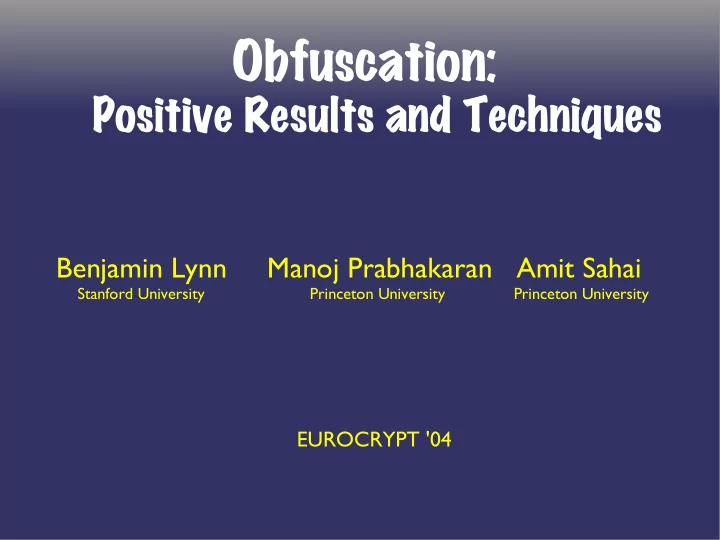

Obfuscation: Positive Results and Techniques Benjamin Lynn Manoj Prabhakaran Amit Sahai Stanford University Princeton University Princeton University EUROCRYPT '04
Obfuscation Hide the internals of a program/circuit Still give complete access to the functionality Obfuscate and handover the code
Obfuscation Privacy, intellectual property protection, ... Numerous cryptographic applications Widespread interest Many proposed schemes
Definition? Introduced in [BGIRSVY'01] Cryptographic perspective: semantic security against “efficient” adversaries Intuition: Obfuscated code doesn't reveal anything more than what access to the functionality does
Definition A family of functions F is obfuscatable if: There is O such that for all F.exe in F , O (F.exe) = ob_F.exe has same behaviour as F.exe ob_F.exe is at most polynomially slower/bigger than F.exe Virtual Blackbox Property
Virtual Blackbox For every adversary A there is a “simulator” S such that for all F.exe in F , what A can find out about F from ob_F.exe , S can find out just from blackbox access to F . | Pr[A(ob_F.exe)=1] - Pr[S F =1] | < negl
Impossibility of Obfuscation [ BGIRSVY'01 ] There are unobfuscatable functions: in par- ticular there are no universal obfuscators Unobfuscatable cryptographic schemes Low-complexity (TC 0 ) unobfuscatable functions
Possibility of Obfuscation? If “learnable” then trivially obfuscatable May be obfuscators for many individual functions of interest At least one non-trivial obfuscation?
Compositions? Suppose F and G obfuscatable { f(g(x)) | f in F , g in G } obfuscatable? In particular, F k obfuscatable? Not necessarily!
Impossibility of Composition Depth 1 threshold circuits: trivially obfuscatable But constant depth threshold circuits (TC 0 ) can be unobfuscatable!
Reductions If F “reduces to” G and G obfuscatable then F also obfuscatable “Blackbox reductions”: given any obfuscator for G give one for F in a blackbox manner
Why Reductions? Easier constructions and proofs If G obfuscated “in hardware”, still can be used to obfuscate F Theoretical interest: New connections between classes of functions
This Work Introduces relevant notions of reduction Reductions of some complex families to a simpler family (“point functions”) Obfuscation of point functions in the “Random Oracle” model
F < G There are two PPT oracle-machines M and N such that for every F in F there is a G in G such that M G = F and N F =G
Using the Reduction Lemma: If F < G and G obfuscatable then F obfuscatable
Proof: Intuition ob_F.exe = M ob_G.exe Ensure that giving ob_G.exe is OK: Giving ob_G.exe is “like” giving blackbox access to G Giving blackbox access to G is not more than giving blackbox access to F , because G = N F
Proof: Sketch ob_F.exe = M ob_G.exe For every adversary A which takes ob_F.exe show a “simulator” S F Consider A' which takes ob_G.exe , constructs ob_F.exe and calls A on that. Consider S' : behaves like A' , but needs oracle access to G S F : run S' with access to N F
Using Reductions A simple family G and a complex family F Show F < G Show how to obfuscate G ( G non-trivial) Lemma gives obfuscation of F
Simple families P the family of point functions: P a (x) = 1 iff x=a Q point functions with output: P a,b (x) = b iff x=a Q* multi-point functions with output: P A,B (x) = B i iff x=A i
A more complex family A Complex Access Control Mechanism: An unknown graph defining access to nodes Each edge has a password Start at start node Exponentially many valid access patterns
Obfuscating it Ideally would like to provide blackbox access to the access controller/secrets in the nodes But what if the code is public? Keep the code obfuscated
Elements of the Obfuscation/proof Probabilistic family W: random keys to nodes ACM < W under an extended definition of “<” From extended Lemma: if the family obtained by fixing the random tape of W in every way obfuscatable, then ACM obfuscatable Fixing tape of W gives multi-point functions
Obfuscating point functions In the Random Oracle model RO a random function Both obfuscator and adversary get oracle access to it ob_F.exe may be different from F with negligible probability (over choice of RO) | Pr[A RO (ob_F.exe)=1] - Pr[S F =1]| < negl
Obfuscating point functions Point function P a : Store RO(a) Point function with output P a,b : Choose r at random. Store r, RO 1 (r,a) and b+RO 2 (r,a) Multiple points: repeat above for each point with different r's
Some Other Obfuscations Public constant size regular expressions with secret strings Public regular expression with secret obfus- catable languages, but giving access to the individual secret languages Neighbourhood checking on tree metrics
Obfuscations via Reductions All reductions to multi-point functions (or underlying obfuscatable functions) No further use of random oracles Useful if the multi-point function primitive can be obfuscated say on hardware
To explore ... More obfuscations and reductions Algorithmic problems Obfuscations without random oracles More impossibilities? Alternate definitions?
Thank You!
Recommend
More recommend